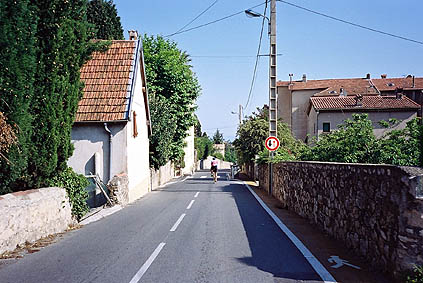 |
 |
Some facts
22 full days of cycling (I cycled a little the first day upon arriving at Nice and cycled 81 km on a travel day). I visited around 115 mountain passes (107 new passes). It was 3532 km for these 22 days, which is like 161 km/day. It was around 73078 m of climbing for 22 days = 3322 m/day. Maximum speed was not so high at 76 km/h (day 13). Maximum inclination/steepness: walking: 33% up Col de Traversette in snow; 42% down Grand col de Ferret. Steepest cycling was perhaps up Monte Zoncolan with 6 km at around 15% on average. Most difficult was probably Koralpenstrasse with an average gradient of 11,2% for the final 14,4 km, which might make it into the hardest climb in the Alps that could be cycled with a normal road bike cycle. Some gravel roads will be harder with a road bike cycle and still be possible, there are also several other roads that are almost as hard – it very much depends upon how one calculates the difficulty. The actual difficulty is most often very dependent upon accidental features like the weather and in what shape you, the road and your bicycle are in. Sometimes it is harder to go on a flat road with heavy traffic and headwind! I wrote last year ”Fortunately, I fully recovered after 3-4 months [after my back injury in Schwaz, Austria]”. – I thought so at the time of writing, but I am still having an occasional little pain due to the accident and had to do special training for the back until just before I went off to the Alps this year. I was not so sure things would work out well this time especially as I stubbornly insisted to use my backpack, but it gave me no more pain than I could accept.
Same info as last year for myself, packaging and the bicycle (new wheels!): The packaging weighed around 3 kg. My bicycle weighs all-in-all (with filled water bottle and tiny saddlebag) around 10 kg. I weigh 87-89 kg. I have 39/53 &12/27 Shimano Dura Ace 9-speed gears. 23” tires. HAC4 cycle computer.
Click here for a revised packaging list. Go to cycloclimbing.com for my other tours and links to sites with more information and help for planning your own trip.
Note: Internet Explorer is not recommended. Instead use a good browser like Opera, Chrome, Safari or Firefox. These pages looks best in Safari on a Mac.
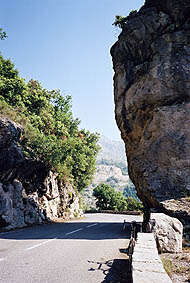
My earlier trips to the Alps left many valleys and passes unexplored. This year’s trip was thus supposed to be a ”the rest of the Alps” tour. It was obvious from start that I would still leave many beautiful and interesting places unexplored – especially the valleys with cul-de-sacs and some mountain roads. I am thinking of places like Juf, Zermatt, Kaunertal, Ahrntal, La Bérarde, Monte Viso, etc. The goal this year was more precisely to make sure I had crossed all paved pass roads over 2000 meters of height in the whole of the Alps. There exists around 80 surfaced mountain passes in the Alps and the Dolomites together. Depending on whom you ask you should get figures between 73 and 83 (if they are very knowledgeable about this). I had 19 more to do for this Summer including some of the most well known passes in the Alps: Hochtor, Simplonpass, Grimselpass, Furkapass, Col du Petit St. Bernard, and Col de Vars.
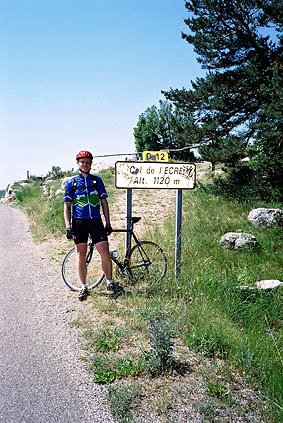
The most easterly place I wished to see this year was Grosse Speikkogel and the Koralpenstrasse, which I have heard should be one of the most hardest mountain roads in the whole of the Alps with the only exceptions of 2-3 roads with gradients of around 37 percent, which would rule them out for me. This is not far from Graz in Austria and is really at the very eastern end of the Alps – the Alps continues a bit further up north-east toward Vienna, but is generally becoming a more hilly, gentle landscape there. At the other end of the Alps I had the most southerly 2000+ meters pass in the Alps to cross – Col des Champs. It was thus clear from start that this tour would include all of the Alps.
Already on the first travel day I had the opportunity to take a little ride on my bicycle. Thanks to the wonderful hospitality of Edith and Bernard Langlade, I had a perfect start and ending of the trip. (Bernard is also a member of Club des Cent Cols (the biggest club for cycloclimbers), like me.) We took a short little ride in the afternoon up to Col de Vence (963 m) (highest col closest to Nice) via D18 (road numbers are worth to note when cycling in France). It was very nice weather, but quite hot. Bernard pointed out that the spectacular column-looking mountain formations above Vence are called ’Bau’ or ’Baou’ (and is a special name only in that part of France). Bau des Blancs is apparently quite popular with climbers.
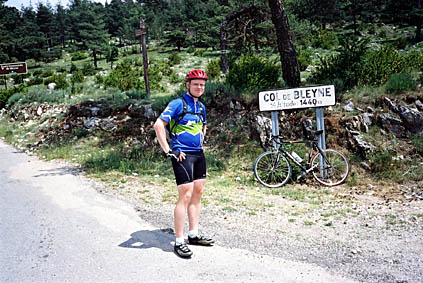
On the way home we passed by the famous village of Saint-Paul where many film stars and other celebrities live (second photo).
I left the next morning on Monday June 28th for the Alps. My plan was to make a record number of cols/passes for one day. (I will write col every now and then instead of pass as it is slightly shorter and most passes in the Alps are titled with the French ’col’.) Maybe it was a new record for me, but I had aimed at doing plenty more than I finally did. The area in this part of France is quite densely populated with passes and makes pass collecting relatively easy. Few passes comes easy though. I headed up from Cagnes-sur-Mer toward the Gorges du Loup. There are Canyons, ”Gorges” and ”Clues” – all being Canyon-like but essentially each is being more narrow and smaller than the other. (Clues seem to break off from rivers and be small openings in the mountainsides and never have any roads and seldom even paths, I believe.)
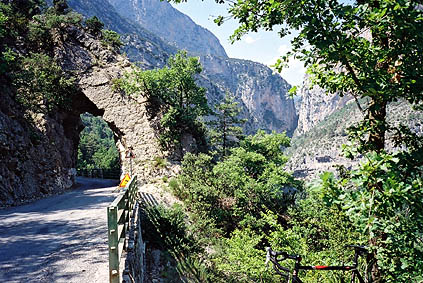
It was a hot day from start and even though I state at the top that I had from 23 Celsius, in fact that was the temperature in the garage in the morning – outside I do not think it was ever under 27 that day. It is especially hot climbing up from the seaside which is typically treeless higher up and thus with no shade. At reaching Gourdon (nicely placed at the gorge) I had to refill the water bottle even before reaching the first col. First photo this day was taken on the way up to Gourdon (739 m). On the way up to Col de l’Ecre 1118 m, I soon noticed another cyclist lower down fighting his way up in the heat. As always if one feels somewhat fresh one does not want to let other people pass by too easily – it is difficult to abstain from being a bit competitive in such circumstances and why not – it is a bit fun after all? – He never caught up with me ;-), but was kind enough to take the first +1000-meter pass photo of me for this year.
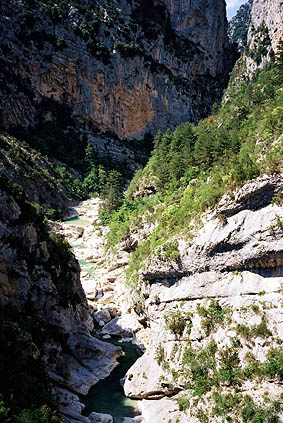
A more attractive and less barren landscape followed. Now it was breathable. Col de l’Ecre was easily the hardest pass for the day. I took a little detour to cross another possible pass I could had taken up here – Col du Ferrier 1041 m (which is as far as I know the most southern tarmacced pass in the Alps above 1000 meters). I went back a little and continued up to Col de la Sine 1108 m. These two passes were easy coming this way. The next two passes were also rather easy: Collet de la Selle 1178 m and Col de Castellaras 1248 m (these are only marked out on walking maps).
Now I arrived at Thorenc (this is not the obvious way to go if going up Col de Bleine/Bleyne as I planned, but it seemed much more interesting and I hoped to get lunch at Thorenc). Thorenc is a small village (as most are in this district), but comes across as a somewhat expensive place with some small fine hotels. One good thing is that they had a good water tap just at the beginning. I decided to sit down at one of 2-3 restaurants – the only one that had any guests (that I saw) and thus I thought it would be a good choice. It turned out to be a VERY ”French” restaurant. Lunch is the most important eating time on the day for the Frenchmen and they spend a long time at it (just like Italians) – down here in southern France. It took over an hour before I could get away again.
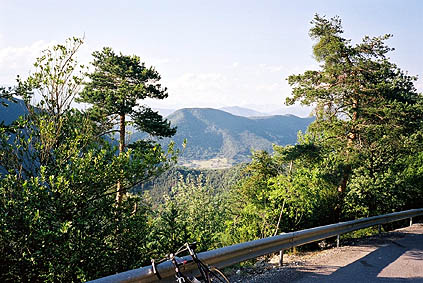
The small road, with worn out pavement up the main road over Col de Bleyne is quite steep (around 16%). Col de Bleyne was the highest pass for the day and for the area at 1440 m. I there met three jolly gents from the UK on typical English Audax bikes. We exchanged photos. (They had the same simple Olympus camera … .) I should have taken a photo of them with my own camera too – they looked a bit like they just had stumbled out of the local pub upon arriving ;-). They had travelled here before and knew it was steep up from the side they came, but Englishmen are used to awkward roads.
Col de Pinpinier 1136 m is situated on a remarkably beautiful small road (the photo below the Bleyne pass). No real climbing here. The road is somewhat flat and later dips down toward the valley floor after the nice miniature village of Le Mas.
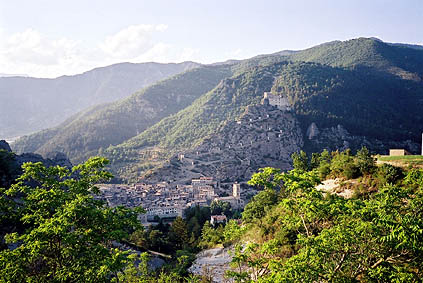
I went zigzagging my way up north (not on the road!). I passed the nice Clue de Aiglun (photo from the bridge above). Then went around the mountainside and crossed three less well-defined passes: Col de la Peire Plantade 710 m, Col St. Marc 725 m, Col St. Roch 747 m. At the latter, I mistakenly went away on a forest road, which turned out very bad (more like a forest path) and later noticed that while this pass was not on the main road, I had been a bit quick at turning off the road and returned after 2 km or so. The road dips to a small village and then a really long frustrating climb with low gradients began (I had not seen that on the map). Finally I arrived in Briançonnet –a village big enough for a shop or two and took time to relax for a while and eat some (cookies and ice cream, I believe).
Col du Buis 1196 m is hard from either side, but slightly easier from Briançonnet. The road is somewhat rough and quite small. From here I had planned to go east yet once again over a supposedly very beautiful road over Col du Trebuchet. But it was getting late and I had to decide whether to try and reach the planned destination for the day or not (I actually had to stop and calculate in my mind for some time. With good planning you have options … :-).)
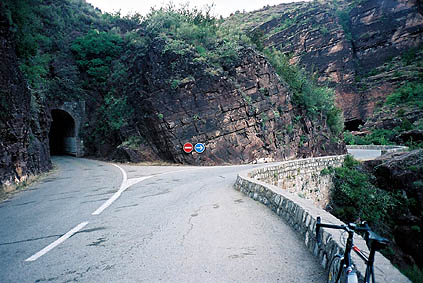
So I decided to not think too much on making a record number of cols and instead hurry on to higher mountains, which after all was more in line with my general aims. Col de Félines 930 m had to be the last little pass for the day (very easy from where I came). Hereafter it was down to Entrevaux, an exciting fortified medieval village where the old border between France and Savoy went until 1860 (Entrevaux were French). Most of the area from Nice up to Switzerland in the Alps was part of Savoy (Savoie), which together with Piedmont (Piemonte) was under Sardinian rule. The Savoyards were then offered to join either France or Italy, but could not join Switzerland as many wanted. There was a dubious vote result with 99.8% wishing to join France.
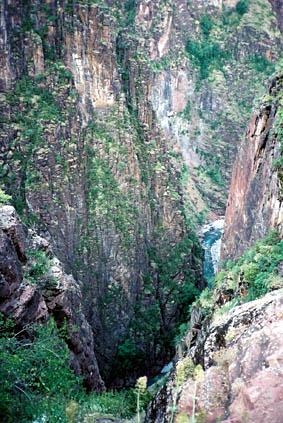
Now I took a rather flat road down the valley westwards. I then found a small gap in the mountainside where a road takes off north up the fantastic Gorges de Daluis. After a while one reaches a landscape with purple coloured mountains. Through these mountains runs a river deep down and a small road clings to the mountainside above. There are very many tunnels which are all (I think) one-directional – which means that if you come from the south you never go through these tunnels but go around the mountain to meet the other road again and again. (Another parallel road up north to the east goes through another gorgeous gorge – the Gorges du Cians, but I had to choose one and this seemed to fit better with my plans.)
After negotiations with a large herd of sheep, I managed to get on to Guillaumes 798 m before dark, which was the end destination planned for and reached! Guillaumes is a small village at the start of the high Alps. It had a few hotels and after asking a local got a tip about which one could be the cheapest of them. I also had to eat there as the 2-3 restaurants in the village closed down at around 9 p.m. (a bit odd). The hotel was okay. Worst thing was my own fault of forgetting my little shampoo bottle in the morning when leaving (everything is very important when travelling with minimal equipment). Let us now move on to some real Alps!
Day 1 – Next Day – Day 3 – Day 4 – Day 5 – Day 6 – Day 7 – Day 8 – Day 9 – Day 10 – Day 11 – Day 12 – Day 13 – Day 14 – Day 15 – Day 16 – Day 17 – Day 18 – Day 19 – Day 20 – Day 21 – Day 22 – Day 23